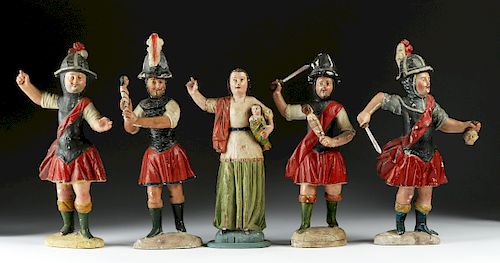19th C. Mexican Wood Santos - Massacre of Innocents
Lot 177
About Seller
Artemis Fine Arts
686 S Taylor Ave, Ste 106
Louisville, CO 80027
United States
Selling antiquities, ancient and ethnographic art online since 1993, Artemis Gallery specializes in Classical Antiquities (Egyptian, Greek, Roman, Near Eastern), Asian, Pre-Columbian, African / Tribal / Oceanographic art. Our extensive inventory includes pottery, stone, metal, wood, glass and textil...Read more
Estimate:
$3,800 - $5,700
Absentee vs Live bid
Two ways to bid:
- Leave a max absentee bid and the platform will bid on your behalf up to your maximum bid during the live auction.
- Bid live during the auction and your bids will be submitted real-time to the auctioneer.
Bid Increments
| Price | Bid Increment |
|---|---|
| $0 | $25 |
| $300 | $50 |
| $1,000 | $100 |
| $2,000 | $250 |
| $5,000 | $500 |
| $10,000 | $1,000 |
| $20,000 | $2,500 |
| $50,000 | $5,000 |
| $100,000 | $10,000 |
| $200,000 | $20,000 |
About Auction
By Artemis Fine Arts
Sep 5, 2019
Set Reminder
2019-09-05 10:00:00
2019-09-05 10:00:00
America/New_York
Bidsquare
Bidsquare : Ancient / Ethnographic From Around The World
https://www.bidsquare.com/auctions/artemis-gallery/ancient-ethnographic-from-around-the-world-4405
Variety galore! Featuring ancient art from Egypt, Greece, Italy and the Near East, as well as Asian, Fossils, Pre-Columbian, Native American, African / Tribal / Oceanic, Spanish Colonial, Russian Icons, Fine art, much more! All categories, all price ranges... Artemis Fine Arts info@artemisgallery.com
Variety galore! Featuring ancient art from Egypt, Greece, Italy and the Near East, as well as Asian, Fossils, Pre-Columbian, Native American, African / Tribal / Oceanic, Spanish Colonial, Russian Icons, Fine art, much more! All categories, all price ranges... Artemis Fine Arts info@artemisgallery.com
- Lot Description
New World, Spanish Colonial Period, ca. 19th century CE. A wonderful gathering of five hand-carved wooden santos, four of which represent soldiers taking part in the biblical "Massacre of the Innocents" and one depicting a standing female holding an infant in her arms. Each of the male santos are shown in a different stance: one holding a sword and a severed head; one holding a sword and a swaddled infant; one holding only an infant; and the last with a raised arm used to wield a sword. Each male figure wears traditional Spanish armor with red sashes and skirts as well as military boots atop a mounded platform, and the woman stands with one upraised arm and wearing a cream-hued gown and an olive skirt. Despite the massacre taking place roughly 2,000 years ago in the Holy Land, its importance to the Christian faith has perpetuated throughout the centuries. These figures represent a Spanish interpretation of the events surrounding the massacre. Size of largest (man holding baby): 4.125" W x 12.3" H (10.5 cm x 31.2 cm).
The "Massacre of the Innocents" was a biblical account of mass infanticide at the hands of the tyrannical ruler King Herod the Great. According to the Gospel of Matthew, the Magi had announced the birth of Jesus Christ, the future King of the Jews, much to the dismay of the current King Herod. Upon receiving this news, King Herod ordered his soldiers to slaughter each young male child within the vicinity of Bethlehem to eliminate any eventual chance that he would be usurped. Hundreds of Herod's troops then swarmed the streets, mercilessly killing every young boy they were able to find. Despite the children being of the Jewish faith, the Christian church anointed every murdered child as a martyr of the Christian faith.
Santos played a key role in bringing the Catholic Church to the New World with the Spanish colonists. These religious figures were hand-carved and often furnished with crowns, jewels, and other accessories, usually funded by religious devotees, and were used as icons to explain the major figures - Mary, Christ, and the saints - to new, indigenous converts. Likewise, they served as a connection to the Old World for Spanish colonists far from home. They became a folk-art tradition in the Spanish New World, from modern day Guatemala to as far north as New Mexico and Colorado. Many of them were lovingly cared for over the years, with repairs and paint added as they aged, and played an active part for a long time in the religious life of their communities.
Provenance: private California, USA collection
All items legal to buy/sell under U.S. Statute covering cultural patrimony Code 2600, CHAPTER 14, and are guaranteed to be as described or your money back.
A Certificate of Authenticity will accompany all winning bids.
We ship worldwide and handle all shipping in-house for your convenience.
#134988Female has stable fissure on verso near base. Man holding nothing has missing fingers and repairs to base, one leg, and one arm. Man with sword and head has repairs to base and both arms. Man holding sword and baby has repairs to base, one arm, and helmet. All figures have surface wear and abrasions commensurate with age, fading and chipping to pigmentation, and wear to some finer details. Light earthen deposits throughout.Condition
- Shipping Info
-
All shipping is handled in-house for your convenience. Your invoice from Artemis Gallery will include shipping calculation instructions. If in doubt, please inquire BEFORE bidding for estimated shipping costs for individual items.
-
- Buyer's Premium



 EUR
EUR CAD
CAD AUD
AUD GBP
GBP MXN
MXN HKD
HKD CNY
CNY MYR
MYR SEK
SEK SGD
SGD CHF
CHF THB
THB
















